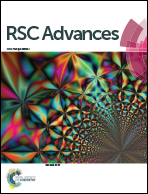Self-assembled Co0.85Se/carbon nanowires as a highly effective and stable electrocatalyst for the hydrogen evolution reaction†
Abstract
Self-assembled Co0.85Se/carbon nanowires, constructed by Co0.85Se nanoparticles homogenously embedded into carbon nanowires (Co0.85Se@CNWs), have been synthesized through a facile solvothermal reaction and selenylation process. Compared to the bare Co0.85Se NWs, the Co0.85Se@CNW hybrid demonstrates high efficiency and stability for HER. It has a small Tafel slope of 43.4 mV dec−1, a low onset potential of 138 mV vs. RHE, and a high cycling stability with more than 95% current retention after 1500 voltammetry cycles. The outstanding HER performance of Co0.85Se@CNWs is attributed to its unique particle-in-nanowire architecture, which not only prevents the Co0.85Se nanoparticles from aggregation, but also provides a highly conductive CNW matrix to promote the charge transfer in the electrocatalytic reaction, further enhancing the catalytic activity. This work provides a new strategy to rationally design transition metal-based selenide hybrids as highly effective and stable electrocatalysts for HER.



 Please wait while we load your content...
Please wait while we load your content...